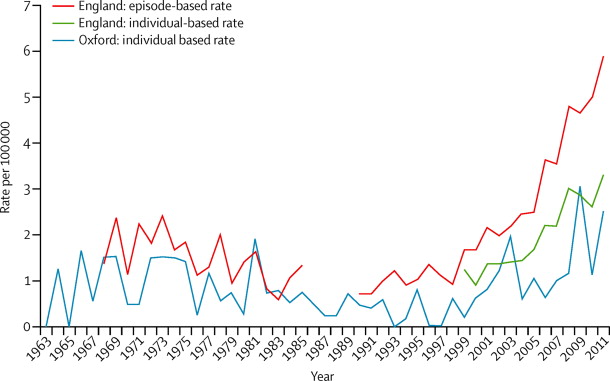Rickets in England – huge recent increase
Hospitalisation for children with rickets in England: a historical perspective
The Lancet, Volume 383, Issue 9917, Pages 597 - 598, 15 February 2014 doi:10.1016/S0140-6736(14)60211-7Cite or Link Using DOI
Michael Goldacre michael.goldacre@dph.ox.axc.uk, Nick Hall, David G R Yeates
Unit of Health-Care Epidemiology, Nuffield Department of Population Health, University of Oxford, Oxford OX3 7LF, UK
Nutritional rickets caused by vitamin D deficiency is associated with a diet deficient in vitamin D, inadequate exposure to sunlight, and reduced endogenous synthesis of vitamin D in the skin. The Chief Medical Officer for England has recently drawn attention, in her annual report, to the continuing problem of vitamin D deficiency in children.1, 2
We have analysed rates of hospital admissions for rickets in England, across five decades, in children younger than 15 years. We analysed data for all England using routinely collected hospital episode statistics for 1968—2011 (no national data for 1986—90). We also analysed data for the former Oxford NHS Region (population about 2·5 million) between 1963 and 2011 using the Oxford record linkage study (ORLS),3 which includes data for all day cases and inpatients. Data in the ORLS from 1963 and in England from 1999 were linked for each individual to distinguish episodes of care (individuals can have more than one episode of care, episode-based analyses) and individuals receiving care (irrespective of the number of episodes, individual-based analyses). Analyses were done by selecting records with International Classification of Diseases (ICD) codes for active rickets (ICD7 code 283, ICD8 265·0, ICD9 268·0, and ICD10 E55·0). Rates were directly standardised using 5-year age groups and the European standard population.
Annual rates —episode-based and individual-based—are shown in the figure.
Hospitalisation rates for rickets were low in the 1960s and 1970s and declined further in the 1980s and 1990s.
They increased in the 2000s.
In ORLS, rates were lowest in 1991—96 at 0·34 children per 100 000 under 15 years (95% CI 0·13—0·55) and
highest in 2007—11 at 1·78 (1·27—2·29).
In all England in 2007—11, the episode-based rate was 4·78 (4·58—4·99) and the person-based rate was 3·16 (3·00—3·33) per 100 000 aged under 15.
Most patients were younger than 5 years.
Ethnic origin is not well recorded in Hospital Episode Statistics but, where recorded,
- 32% of the people with rickets were white
- (compared with 83% in the general population younger than 15 years),4
33% south Asian (vs 8%),
33% black (vs 3%), and
2% other non-white (vs 6%).
Their duration of residence in the UK is unknown.
Between 2001 and 2009, the
number of white children in England fell by 6% and the
number of non-white children increased by 19%.4
Figure 1

Rickets in children younger than 15 years: age-standardised rates per 100 000 younger than 15 years in England and in Oxford
Red: Episode-based rates (hospital discharges) for England, 1968–2011. Between 1968 and 1985, the data were a one in 10 sample of all NHS hospital discharges (excluding day cases), then termed the Hospital In-Patient Enquiry, and we scaled to 100% by multiplying each number of annual admissions for rickets by 10. There were no national data for 1986–90. Between 1990 and 2011, the Hospital Episode Statistics included day cases (patients admitted to hospital who did not stay overnight) and inpatients.
Green: individual-based rates for England, from 1999.
Blue: individual-based rates for Oxford, from the Oxford record linkage study.3
The increase in rates might be a reflection of increased incidence or severity of rickets, or changes in admission thresholds, diagnostic, or coding practices.
However, with other reports of a recent increase in rickets,2, 5 the previous hypothesis was that a rise in hospitalisation rates might occur.
The coding of rickets is straightforward, given the diagnosis; and the same exact term, active rickets, was used in the ICD in all decades studied.
Between 1968 and 1985, Hospital In-Patient Enquiry and ORLS were collected independently of each other; each shows the same profile suggesting face validity at least at that time.
Hospitalisation rates for rickets in England are now the highest in five decades.
Currently, rickets is not confined to non-white people, though it is more common in non-white than white individuals.
There is a case for a national confidential audit of rickets.
We declare that we have no conflicts of interest.
References
1 Davies SC, Lemer C, Strelitz J, Weil L. Our children deserve better: prevention pays. Lancet 2013; 382: 1383-1384. Full Text | PDF(47KB) | CrossRef | PubMed
2 Davies SC. Annual report of the Chief Medical Officer. Our children deserve better: prevention pays. London: Department of Health, 2012.
3 Chou MR, Malik AN, Suleman M, Gray M, Yeates D, Goldacre MJ. Time trends over five decades, and recent geographical variation, in rates of childhood squint surgery in England. Br J Ophthalmol 2013; 97: 746-751. CrossRef | PubMed
4 Office for National Statistics. Population estimates by ethnic group.
- http://www.ons.gov.uk/ons/taxonomy/index.html?nscl=Population+Estimates+by+Ethnic+Group#tab-data-tables. (accessed Dec 23, 2013).
- 5 Ahmed SF, Franey C, McDevitt H, et al. Recent trends and clinical features of childhood vitamin D deficiency presenting to a children's hospital in Glasgow. Arch Dis Child 2011; 96: 694-696. CrossRef | PubMed
See also VitaminDWiki
Rickets: Less costly to prevent than to treat SE Asians in UK – 2006 but no one is listening
Why are so many Victorian killer illnesses making a comeback - Nov 2012
Overview of Rickets and vitamin D contains the following summary
{include}
See also web
- Rate of rickets in the United Kingdom highest in 50 years Vitamin D Council on this study - behind a $5/month paywall
- They found that the rate of rickets was highest between 2007 and 2011, with 3.16 cases per 100,000 children.
- This is in comparison to 0.34 cases per 100,000 children between 1991 and 1996.
